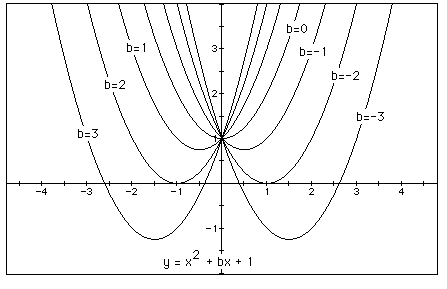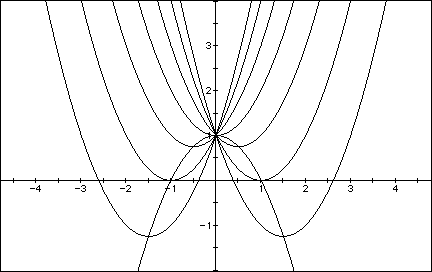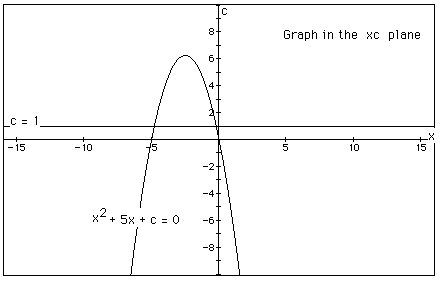
The Department of Mathematics Education

It has now become a rather standard exercise, with available
technology, to construct graphs to consider the equation
and to overlay several graphs of
for different values of a, b, or c as the other two are held
constant. From these graphs discussion of the patterns for the
roots of
can be followed. For example, if we set
for b = -3, -2, -1, 0, 1, 2, 3, and overlay the graphs, the
following picture is obtained.

We can discuss the "movement" of a parabola as b
is changed. The parabola always passes through the same point
on the y-axis ( the point (0,1) with this equation). For b <
-2 the parabola will intersect the x-axis in two points with positive
x values (i.e. the original equation will have two real roots,
both positive). For b = -2, the parabola is tangent to the x-axis
and so the original equation has one real and positive root at
the point of tangency. For -2 < b < 2, the parabola does
not intersect the x-axis -- the original equation has no real
roots. Similarly for b = 2 the parabola is tangent to the x-axis
(one real negative root) and for b > 2, the parabola intersects
the x-axis twice to show two negative real roots for each b.
Now consider the locus of the vertices of the set of parabolas
graphed from
Show that the locus is the parabola
Generalize.

Consider again the equation
Now graph this relation in the xb plane. We get the following
graph.

If we take any particular value of b, say b = 3, and overlay
this equation on the graph we add a line parallel to the x-axis.
If it intersects the curve in the xb plane the intersection points
correspond to the roots of the original equation for that value
of b. We have the following graph.

For each value of b we select, we get a horizontal line. It is clear on a single graph that we get two negative real roots of the original equation when b > 2, one negative real root when b = 2, no real roots for -2 < b < 2, One positive real root when b = -2, and two positive real roots when b < -2.
We see what happens when c = 1 but let's look at various values of c. First let's compare for different c > 0:


Notice this pattern repeats for other c > 0. The range of
b values when no real roots exists grows as c increases. It should
be clear that when c > 0 we will always have a range of b values
where no real roots exist. Likewise, if roots exist, then they
will be either both positive and both negative.
Consider the case when c = - 1 rather than + 1.

For each and every horizontal line that is picked, it is clear that there will be two points of intersection of the curve thus having two real roots. It is also noteworthy that one of the roots will be positive and one will be negative.
Consider the case for various c < 0:


Graphically the pattern for c < 0 still remains intact. For any b in the quadratic there still exists two real roots. One will be positive while the other will be negative.
We have investigated different positive and negative values for c but let's show that the investigation works perfectly for c = 0.
Algebraically the roots can be found easily:

Graphically the solutions from the algebraic solutions also make up the graph:

Notice for value of b = 4 we get two roots x = 4 and x = 0. Visually the zero root is not easily seen due to the axis so lets do a linear transformation to illustrate the zero. If we replace x - 1 for x algebraically our roots will be:

Graphically:

With the linear transformation we can easily see the vertical line that was not visual with the first graph. We also see the two roots were identical to those shown algebraically.
With this demonstration we have show graphically the quadratic formula for the x-b plane. It is also noteworthy to show that with these different values for c for this x-b plane exercise we have shown all hyperbolas in the x-y plane of the form
Note the asymptotes for the hyperbola when c = 0.

In the following example the equation
is considered. If the equation is graphed in the xc plane,
it is easy to see that the curve will be a parabola. For each
value of c considered, its graph will be a line crossing the parabola
in 0, 1, or 2 points -- the intersections being at the roots of
the original equation at that value of c. In the graph, the graph
of c = 1 is shown. The equation
will have two negative roots -- approximately -0.2 and -4.8.

There is one value of c where the equation will have only 1
real root -- at c = 6.25. For c > 6.25 the equation will have
no real roots and for c < 6.25 the equation will have two roots,
both negative for 0 < c < 6.25, one negative and one 0 when
c = 0 and one negative and one positive when c < 0.